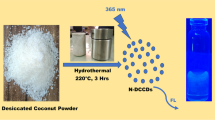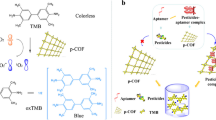Abstract
A new nanozyme (Cu-NADH) is reported composed of Cu-coordinated nicotinamide adenine dinucleotide (NADH) exhibiting laccase-like activity. The Cu-NADH nanozyme had higher heat tolerance and catalytic efficiency than natural laccase, and its catalytic activity can be enhanced by high concentration of Cl ions and it is intensely inhibited by phosphate. Therefore, a colorimetric method based on Cu-NADH and indigo carmine was successfully developed to detect phosphate in water. This method showed an excellent selectivity for phosphate, and it had a linear relationship in the phosphate concentration range 2–50 μM with a detection limit of 0.37 μM. We believe that this example of coordination between metal ions and biomolecules to mimic natural enzymes can inspire more effective and alternative strategies in nanozyme design and expand their use in sensing and determination.
Graphical abstract






Similar content being viewed by others
References
Huang G, Zhang D (2020) The plasticity of root systems in response to external phosphate. Int J Mol Sci 21(17):5955. https://doi.org/10.3390/ijms21175955
Marks J (2019) The role of SLC34A2 in intestinal phosphate absorption and phosphate homeostasis. Pflugers Arch 471(1):165–173. https://doi.org/10.1007/s00424-018-2221-1
Chen YC, Lo KM, Wang YX, Chiu TC, Hu CC (2020) A sensitive colorimetric probe for detection of the phosphate ion. Sci Rep 10(1):21215. https://doi.org/10.1038/s41598-020-78261-x
Huang W, Zhang Y, Li D (2017) Adsorptive removal of phosphate from water using mesoporous materials: a review. J Environ Manage 193:470–482. https://doi.org/10.1016/j.jenvman.2017.02.030
He J, Sun H, Dai J, Wang H, Yu L, Zhou W, Shao Z (2020) In situ growth of nanoflake and nanoflower-like Ni hydrated hydroxide on the surface of Ni foam as a free-standing electrode for high-performance phosphate detection. J Hazard Mater 392:122313. https://doi.org/10.1016/j.jhazmat.2020.122313
Wang J, Li W, Zheng Y-Q (2020) Colorimetric assay for the sensitive detection of phosphate in water based on metal–organic framework nanospheres possessing catalytic activity. New J Chem 44(45):19683–19689. https://doi.org/10.1039/d0nj04164e
Yang L, Sturgeon RE, Lam JWH (2001) On-line determination of dissolved phosphate in sea-water by ion-exclusion chromatography inductively coupled plasma mass spectrometry. J Anal At Spectrom 16(11):1302–1306. https://doi.org/10.1039/b104634a
Xu J, Zhou Y, Cheng G, Dong M, Liu S, Huang C (2015) Carbon dots as a luminescence sensor for ultrasensitive detection of phosphate and their bioimaging properties. Luminescence 30(4):411–415. https://doi.org/10.1002/bio.2752
Giardina P, Faraco V, Pezzella C, Piscitelli A, Vanhulle S, Sannia G (2010) Laccases: a never-ending story. Cell Mol Life Sci 67(3):369–385. https://doi.org/10.1007/s00018-009-0169-1
Wang J, Huang R, Qi W, Su R, Binks BP, He Z (2019) Construction of a bioinspired laccase-mimicking nanozyme for the degradation and detection of phenolic pollutants. Appl Catal B 254:452–462. https://doi.org/10.1016/j.apcatb.2019.05.012
Wu J, Wang X, Wang Q, Lou Z, Li S, Zhu Y, Qin L, Wei H (2019) Nanomaterials with enzyme-like characteristics (nanozymes): next-generation artificial enzymes (II). Chem Soc Rev 48(4):1004–1076. https://doi.org/10.1039/c8cs00457a
Huang Y, Ren J, Qu X (2019) Nanozymes: classification, catalytic mechanisms, activity regulation, and applications. Chem Rev 119(6):4357–4412. https://doi.org/10.1021/acs.chemrev.8b00672
Fan K, Wang H, Xi J, Liu Q, Meng X, Duan D, Gao L, Yan X (2016) Optimization of Fe3O4 nanozyme activity via single amino acid modification mimicking an enzyme active site. Chem Commun (Camb) 53(2):424–427. https://doi.org/10.1039/c6cc08542c
Fan L, Lou D, Wu H, Zhang X, Zhu Y, Gu N, Zhang Y (2018) A novel AuNP‐based glucose oxidase mimic with enhanced activity and selectivity constructed by molecular imprinting and O2-containing nanoemulsion embedding. Adv Mater Interfaces 5(22):1801070. https://doi.org/10.1002/admi.201801070
Yao L, Zhao MM, Luo QW, Zhang YC, Liu TT, Yang Z, Liao M, Tu P, Zeng KW (2022) Carbon quantum dots-based nanozyme from coffee induces cancer cell ferroptosis to activate antitumor immunity. ACS Nano. https://doi.org/10.1021/acsnano.2c01619
Alizadeh N, Ghasemi S, Salimi A, Sham TK, Hallaj R (2020) CuO nanorods as a laccase mimicking enzyme for highly sensitive colorimetric and electrochemical dual biosensor: Application in living cell epinephrine analysis. Colloids Surf B Biointerfaces 195:111228. https://doi.org/10.1016/j.colsurfb.2020.111228
Wang Y, He C, Li W, Zhang J, Fu Y (2017) Catalytic performance of oligonucleotide-templated Pt nanozyme evaluated by laccase substrates. Catal Lett 147(8):2144–2152. https://doi.org/10.1007/s10562-017-2106-5
Guan M, Wang M, Qi W, Su R, He Z (2020) Biomineralization-inspired copper-cystine nanoleaves capable of laccase-like catalysis for the colorimetric detection of epinephrine. Front Chem Sci Eng 15(2):310–318. https://doi.org/10.1007/s11705-020-1940-y
Zhang X, Wu D, Wu Y, Li G (2021) Bioinspired nanozyme for portable immunoassay of allergenic proteins based on A smartphone. Biosens Bioelectron 172:112776. https://doi.org/10.1016/j.bios.2020.112776
Xu X, Wang J, Huang R, Qi W, Su R, He Z (2021) Preparation of laccase mimicking nanozymes and their catalytic oxidation of phenolic pollutants. Catal Sci Technol 11(10):3402–3410. https://doi.org/10.1039/d1cy00074h
Liang H, Lin F, Zhang Z, Liu B, Jiang S, Yuan Q, Liu J (2017) Multicopper laccase mimicking nanozymes with nucleotides as ligands. ACS Appl Mater Interfaces 9(2):1352–1360. https://doi.org/10.1021/acsami.6b15124
Huang H, Bai J, Li J, Lei L, Zhang W, Yan S, Li Y (2019) Fluorometric and colorimetric analysis of alkaline phosphatase activity based on a nucleotide coordinated copper ion mimicking polyphenol oxidase. J Mater Chem B 7(42):6508–6514. https://doi.org/10.1039/c9tb01390c
Huang H, Li M, Hao M, Yu LL, Li Y (2021) A novel selective detection method for sulfide in food systems based on the GMP-Cu nanozyme with laccase activity. Talanta 235:122775. https://doi.org/10.1016/j.talanta.2021.122775
Sun J, Ge J, Liu W, Lan M, Zhang H, Wang P, Wang Y, Niu Z (2014) Multi-enzyme co-embedded organic-inorganic hybrid nanoflowers: synthesis and application as a colorimetric sensor. Nanoscale 6(1):255–262. https://doi.org/10.1039/c3nr04425d
Jones SM, Solomon EI (2015) Electron transfer and reaction mechanism of laccases. Cell Mol Life Sci 72(5):869–883. https://doi.org/10.1007/s00018-014-1826-6
Qian L, Li X, Qi F, Li J, Lu L, Xu Q (2017) An amino-functionalized grooved nanofiber mat for solid-phase extraction of phenolic pollutants. Microchim Acta 184(8):2861–2870. https://doi.org/10.1007/s00604-017-2313-1
Morrison JF (1969) Kinetics of the reversible inhibition of enzyme-catalysed reactions by tight-binding inhibitors. Biochim Biophys Acta (BBA) Enzymol 185(2):269–286. https://doi.org/10.1016/0005-2744(69)90420-3
Johannes C, Majcherczyk A (2000) Laccase activity tests and laccase inhibitors. J Biotechnol 78(2):193–199. https://doi.org/10.1016/S0168-1656(00)00208-X
Morpurgo L, Graziani MT, Agostinelli E, Desideri A (1986) An EPR study on the conformation of the copper sites of Japanese lacquer-tree laccase. J Inorg Biochemi 28(2):189–193. https://doi.org/10.1016/0162-0134(86)80082-4
Yan N, An M, Chu J, Cao L, Zhu G, Wu W, Wang L, Zhang Y, Rittmann BE (2021) More rapid dechlorination of 2,4-dichlorophenol using acclimated bacteria. Bioresour Technol 326:124738. https://doi.org/10.1016/j.biortech.2021.124738
Refat HAH, Hassan AI, Hassan YF, El-Wekil MM (2021) Colorimetric and fluorometric nanoprobe for selective and sensitive recognition of hazardous colorant indigo carmine in beverages based on ion pairing with nitrogen doped carbon dots. Food Chem 349:129160. https://doi.org/10.1016/j.foodchem.2021.129160
Choi K-Y (2021) Discoloration of indigo dyes by eco-friendly biocatalysts. Dyes Pigm 184:108749. https://doi.org/10.1016/j.dyepig.2020.108749
Li X, Liu B, Ye K, Ni L, Xu X, Qiu F, Pan J, Niu X (2019) Highly sensitive and specific colorimetric detection of phosphate by using Zr (IV) to synergistically suppress the peroxidase-mimicking activity of hydrophilic Fe3O4 nanocubes. Sens Actuators B Chem 297:126822. https://doi.org/10.1016/j.snb.2019.126822
Funding
This work was supported by grants from the National Natural Science Foundation of China [82172100] and the Project of Science and Technology Department of Jilin Province, China [No. 20170204027NY, 20200801015GH, 20200404100YY, 20210402039GH].
Author information
Authors and Affiliations
Contributions
Sijun Huang and Xuyong Tang: the equally contributed authors to this work, either the original and revised work. Liqiang Yu and Shiyin Hong: they mainly help to prepare the Cu-NADH nanozymes, evaluate the laccase-like activity, and do some work on real samples determination. Jihuan Liu: who mainly help to investigate the effect of NaCl on Cu-NADH nanozymes. Baofeng Xu and Rui Liu: who mainly help to discuss and review the paper. Yi Guo and Li Xu: they are corresponding authors of this work provide resources and help to write, review, and edit.
Corresponding authors
Ethics declarations
Competing interest
The authors declare no competing interests.
Additional information
Publisher's note
Springer Nature remains neutral with regard to jurisdictional claims in published maps and institutional affiliations.
Supplementary Information
Below is the link to the electronic supplementary material.
Rights and permissions
Springer Nature or its licensor holds exclusive rights to this article under a publishing agreement with the author(s) or other rightsholder(s); author self-archiving of the accepted manuscript version of this article is solely governed by the terms of such publishing agreement and applicable law.
About this article
Cite this article
Huang, S., Tang, X., Yu, L. et al. Colorimetric assay of phosphate using a multicopper laccase-like nanozyme. Microchim Acta 189, 378 (2022). https://doi.org/10.1007/s00604-022-05476-2
Received:
Accepted:
Published:
DOI: https://doi.org/10.1007/s00604-022-05476-2




